BY RICHARD CONNIFF
It seemed to me that leopards had left their footprints not just on the African earth but also in our own genetic heritage. One time in Botswana's Okavango Delta, I went out with a friend named Dave Hamman to inspect a sausage pod tree. It was a big old monster of a tree, 8 feet across at the bottom and maybe 40 feet tall. It was just the shape that humans find innately appealing, scientists have suggested, because its great, spreading branches would have provided our simian ancestors with some refuge from leopards. It's what we really mean when we talk about a picturesque tree. The sausage pod tree was also a species monkeys loved to visit to feed on its huge seedpods. But this tree contained a surprise: the trunk divided about six feet off the ground, and there was a deep hollow just below the split, with a worn-smooth lower lip, and a sort of knob like a stoop just outside. A leopard was said to be using the hollow as a den for her cubs.
We found the leopard herself a half-mile down the road. She lay in the shade, panting. With binoculars I looked into her vast khaki-colored eyes, and the crimson veins at the edge of the cornea seemed to swell and darken as she stared back. She closed her eyes again, and her head inclined. She moved off after a bit, and when she stepped into the tall grass, she vanished like one of the players in Field of Dreams. Her yellow fur blended perfectly with the dry grass blades. Her black spots disappeared among the dark spaces where the blades of grass crossed one another close to the ground.
Hamman figured the leopard was heading homeward, and we drove ahead to wait at the sausage pod tree. We passed a half-hour or so trading leopard lore. I told him about a recent study on vervet monkeys on Barbados. Neither these monkeys nor any of their ancestors had actually seen a leopard since their importation from West Africa in the mid-16th century. But they still panicked at the sight of leopard spots. It was apparently embedded in their genes. Richard Coss at the University of California, Davis has suggested that a similar genetic heritage may be the reason kings, tribal leaders and fashionable women are inclined to favor leopard-print clothing: leopards still make us a little gaga.
Just then, the female showed up. She paused and snapped at a fly that was bothering her. Then, as she approached the sausage pod tree, she made a soft coughing sound, to let the cubs within know mama was home. She leaped up onto the knob of the tree. She peered into the den. Then she squeezed her way down into the narrow opening. Her tail lingered outside. But after a moment, it vanished, too, and the tree became just a tree again, betraying no hint of the fierce life huddled up in its heart.
END
(NOTE: You can find this story, and others like it, in my book Swimming with Piranhas at Feeding Time)


